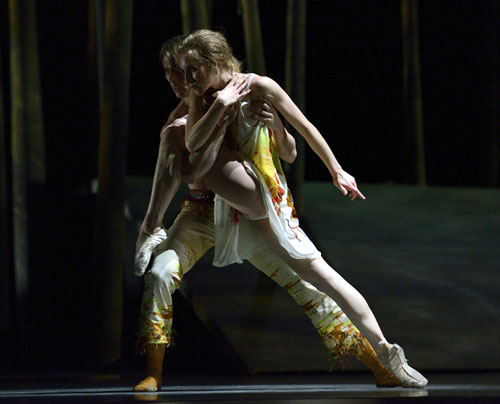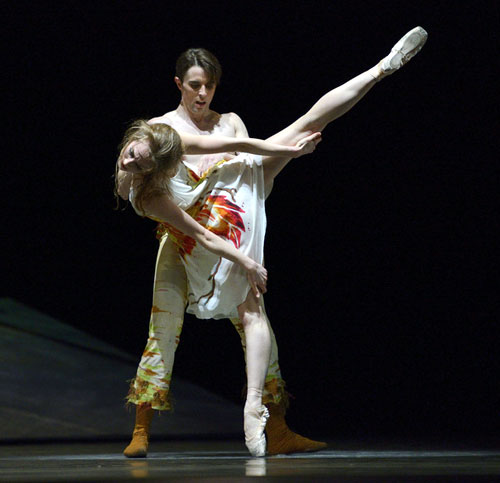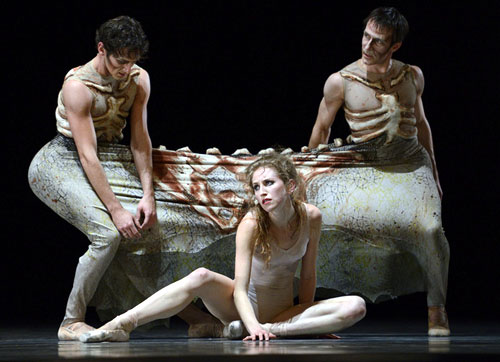|
The young composer Igor Stravinsky was summoned one spring afternoon to Sergei Diaghilev's home about a hundred years ago. Stravinsky knew Diaghilev only by reputation. He was the daring catalyst breathing new life into the arts in St. Petersburg and beyond. Neither of those great 20th century characters was known outside a small circle of artists and intellectuals. Yet.
Arriving at the appointed hour, Stravinsky, a young man in his 20s, waited in the foyer as he overheard laughter coming from the inner rooms at Diaghilev's residence. He became impatient and indignant that he was being asked to wait for the meeting. He jumped to his feet and reached for the door. Diaghilev suddenly appeared and invited him in to discuss a plan to commission a score for the choreography of Mikhail Fokine based on the Russian folktale, "Firebird." This was an important step in Diaghilev's master plan to invent Russian ballet. "Firebird" became the first of several works that were created by Russian artists, based on Russian themes, for the Ballets Russes to perform outside of Russia for non-Russian audiences. Until the early 20th century, and Diaghilev's ascension as impresario and mastermind, Russian ballet companies had only performed works created by French and Italian choreographers.
The success of Stravinsky's "Firebird" led Diaghilev to commission another new work and it was this one that would radically change everything in both ballet and classical music: "Rite of Spring." Late in his life, Stravinsky wondered aloud if he had departed in anger through that door at Diaghilev's whether he would ever have written the composition that shook Paris audiences out of their complacent waking slumber and shocked the world into the modern era.
The original Ballets Russes performance of "Rite of Spring" has spawned dramatic mythology about the audience response to the raucous Stravinsky score, the bizarre Nijinsky choreography, the heavy peasant costumes and the radical departure from delicate romanticism. The numerous accounts of the premiere performance in late May 1913 uniformly include stories of battling camps within the Théâtre des Champs Elysées simultaneously praising and decrying the music and choreography. Stravinsky supposedly stomped away from his seat he was so unnerved by the audience's irreverence. People who were there claimed it was a near-violent clash between the modern-leaning aesthetes and the leaden traditionalists. People who weren't there simply claimed that they were.
In the proceeding one hundred years, many attempts have been made to recreate "Rite of Spring." Because the music was so drastically different from anything written before it, there was no notation for documenting it, let alone providing a score for the musicians. Stravinsky invented his own system for noting the complex rhythms and new harmonies. Nijinsky's choreography was never documented at all except for a few photos and extensive notes made by the choreographer and others who witnessed its creation, rehearsal and performances. These problems have been more or less solved and companies including the Bolshoi in Russia and the Joffrey in the United States have staged credible recreations. Compared to the tales about Ballets Russes' original performance I found these attempts not only tame but soporific in their enactments of the Stravinsky rhythms.
As choreographer-in-residence for San Francisco Ballet, Yuri Possokhov was asked to bring forth his own "Rite of Spring" for its 100th anniversary. A former Bolshoi and San Francisco Ballet dancer who was also well schooled in Russian folk dance and art history, he knew the day would come when he would wrestle with the story of human sacrifice as a pagan ritual. Fortunately, he did not seek to stage a mere recreation. His "Rite of Spring" drew upon the original for the music, themes and only a few movement motifs and body positions. Always a thoughtful creative force whose work impresses by its grand vision and astute attention to details, his "Rite of Spring" felt fresh and yet timeless.
The stage set, designed by Benjamin Pierce, also a former San Francisco Ballet dancer, was at once rustic, modern and futuristic. A silvery platform, tilted upward toward upstage, was surrounded by post-apocalyptic barren trees. Upon this stark platform a group of young women began stretching their arms, legs and torsos in gestures suggesting their awakening fertility. They slid down the platform, legs spread wide open, to frolic alone and in small groups, toying with each other, lifting their diaphanous dresses and writhing to the irresistible Stravinsky rhythms.
The tall and lithe Jennifer Stahl immediately captured attention with her awkward elegance and wild, off-balance movements. At times she appeared to be all elbows and knees as she folded and twisted her body into geometric shapes and animal-like poses. The girls all wore their hair in crazy, barely controlled nests of frizz which looked perfectly appropriate as they thrashed around the stage, their long and lovely limbs flailing gracefully and with passionate abandon. Stravinsky's opening stabs straight to the heart.
 |
Soon four then ten more warrior-predators appear. Stahl takes the lead in tempting the boys by lifting her dress over her head in a gesture that soon spreads throughout the group. The warrior-predators circulate and select partners. Here Possokhov begins to build suspense by hinting at the male dancers' threatening potential just beneath the surface of their playfulness. Luke Ingham and Jennifer Stahl begin their highly physical pas de deux looking at times like children challenging each other to go further and further. He threw her from side to side and she rebounded off his arms like a wild animal caught in a cage.
 |
The stage fills with mayhem, the music blares and the girls are stripped of their dresses, dancing only in nude bodysuits. The whole group engages in a Sufi-like spinning frenzy until the sudden appearance of a hideous four-legged monster (Garen Scribner and James Sofranko). The two dancers are attached by a skirt painted with the bones of a giant pelvis splashed with blood. This horrifying creature represents the shaman-elder influence that demands a ritual sacrifice to mark the coming of spring. Caught in the spell cast by the presence of this ancient force, the dancers' movements become more ritualized and the tension mounts. The dancers' expressions become lifeless like zombies as their bodies respond to the music by stomping and gesturing with disembodied limbs. James Sofranko and Garren Scribner inhabit their character with absolute menace. They shape-shift into grotesque postures by counterbalancing against each other as the costume stretches to contain and support them. At one point they appear to lie down creating a tabletop with their torsos horizontal to the floor. A four-legged beast on the prowl.
 |
Once the shaman-monster leaves the stage, the couples return to their joyous mischief-making. Their previous naivety is now weighted by the ominous, frenetic music blaring from expanded orchestra (brilliantly conducted by Martin West). When the monster reappears, it pounds large sticks rhythmically against the floor adding another layer of rhythm to the cacophony. The insistence of the pounding of the sticks and the relentless Stravinsky rhythms build to a climax as the monster demands a sacrifice. The entire group now wields sticks and turns on Jennifer Stahl. She is hoisted upon two long parallel poles, her elbows crooked over the top pole and her knees splayed over the lower one. She is carried around the stage and back up the ramp from which she originally slithered as the others dancers continue in a trancelike ritual, staring robotically forward into the open space beyond, each of them pounding a stick against the ground. Finally, she is dropped to ground, surrounded by the group and strapped to the ropes that dangle from opposing trees. When the trees snap back into position the ritual offering of a young woman's life is complete.
Before the opening of the original "Rite of Spring" in 1913, Nijinsky described to Stravinsky how he imagined the audience would react, "…it will open new horizons. Wider horizons, flooded with sunlight. They will glimpse new colors, new lives. Everything different—new, beautiful." It's a lot to ask of a piece of music and dance but it seems that he was right. The original heralded the death of the old forms and the insistent birth of the new.
In resurrecting Stravinsky's score and re-examining the original animating ideas from Nijinsky's "Rite of Spring," Possokhov has not caused a revolution nor replicated a classic. He and his collaborators have movingly and beautifully celebrated the timeless horror and beauty of death and its promise of rebirth.
Winter ends and spring arrives. We glimpse new colors, new lives. Everything different—new, beautiful.
All photographs courtesy of San Francisco Ballet © Erik Tomasson
|